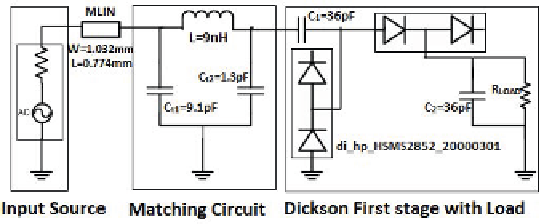Information Technology Reference
In-Depth Information
The received signal strength diminishes with the square of the distance and
frequency. The main challenge faced in harvesting RF energy is the free-space
path loss of the transmitted signal with distance[3], it requires special sensitivity
considerations in the circuit design. In this section We describe a new circuit that
is capable of harvesting energy with high eciency. Beginning with the selection
of the circuit components, we choose the Dickson topology as shown in Fig.2, in
this configuration parallel capacitors in each stage reduces the circuit impedance
and hence, makes the matching task simpler[3]. In the following, we describe the
design strategies for ecient RF energy harvesting circuit and its performance.
2.1 Selection of Matching Circuit
One of the crucial requirement of energy harvesting circuit is to transfer the total
received power from antenna to the rectifier circuit. This can be done by proper
selection of matching circuit and its components parameters, due to non-linear
dependence of the rectifier impedance on the frequency and power, broadband
impedance matching network is essential for maximum power transfer. If RF cir-
cuit is not matched we get reflected power, this reflected power builds standing
waves on the transmission line between the source and load. Depending on the
phase between the forward and reflected waves can either subtract or add. Be-
cause of that on the line we can get places where the voltage is the sum of both
voltages or eventually places where the voltage equals zero (maximum current).
If the standing wave is positioned in such a way on the transmission line so that
the maximum voltage or current is applied to the circuit, they can be destroyed.
There are various type of matching topologies are available such as resistive
matching network that include only one resistor, here matching will be achieved
but it is not a desirable solution because in resistive matching most of the power
will be lost in the resistor. Another topology is transformer matching, it con-
verts source power from one voltage and current level to another voltage and
current level. Disadvantage of transformer matching is that it can match only
the real part of the impedance, if there is a large amount of reactance in the
load, a transformer will not eliminate these reactive components. Transformers
however, works poorly at microwave frequencies. The L type matching network
Fig. 2.
Equivalent circuit of 1
st
stage harvester circuit

